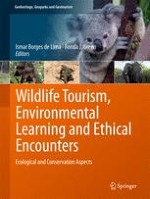2017 | OriginalPaper | Buchkapitel
5. The Intersections Between Lacustrine Wildlife Tourism and Conservation: Scientific and Educational Opportunities in the Brazilian Southern Lakes
verfasst von : Rosane Maria Lanzer, Rita Gabriela Araujo Carvalho, Aline Correa Mazzoni
Erschienen in: Wildlife Tourism, Environmental Learning and Ethical Encounters
Aktivieren Sie unsere intelligente Suche, um passende Fachinhalte oder Patente zu finden.
Wählen Sie Textabschnitte aus um mit Künstlicher Intelligenz passenden Patente zu finden. powered by
Markieren Sie Textabschnitte, um KI-gestützt weitere passende Inhalte zu finden. powered by
